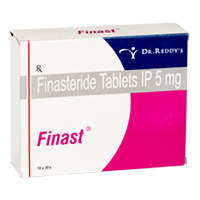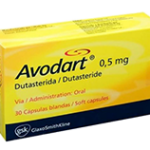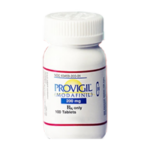
Finast

What is Finasteride – mechanism of action

Finasteride is a synthetic drug produced by the American multinational Merck. It was initially conceived as a cure for benign prostatic hypertrophy and prevention for prostate cancer, but it is later discovered to have positive effects in combating androgenetic alopecia and other forms of hair loss.
The 5-alpha-reductase enzyme is responsible for converting the hormone testosterone to dihydrotestosterone (DHT), which is one of the main factors of male pattern baldness; not by chance the concentration of dihydrotestosterone is much higher in men than in women. The enzyme 5-alpha-reductase, in addition to promoting hair loss through the production of dihydrotestosterone, stimulates the abnormal growth of body hair, as well as the hyperactivity of the sebaceous glands with consequent excessive production of sebum (seborrhea) and possible problems with scalp.
Finasteride, acting selectively as an inhibitor of the activity of the 5-alpha-reductase enzyme, prevents the conversion of testosterone into dihydrotestosterone, helping to counter androgenetic alopecia. In fact, as the levels of DHT decrease, the process of miniaturization of hair inside hair follicles, often accelerated by the concomitant seborrhea, is also significantly slowed. Finasteride therefore does not produce hair regrowth, but slows the fall.
The drug slows down DHT conversion which is a testosterone derivative responsible for loosening of hair bulbs which further causes hairline to recede according to male pattern – a condition known as alopecia. The drug is only used for men. Finasteride blocks the conversion of testosterone to an androgen, which is what scientists believe cause hair loss.
Studies have also shown that the drug can also be successful against prostate cancer. From the pharmaceutical industry, on the other hand, it is usually mentioned that 1 in 1000 people get erectile problems.
Finasteride dosage
The main drugs based on the active ingredient of finasteride are Proscar, Propecia and its generic Finast. The latter contains the concentration (5mg) of finasteride ideal for the treatment of baldness (androgenetic alopecia) when split in 5 doses, which is beneficial for pharmacy bill savings.
The drug is supposed to be taken as directed by prescriber. The general rule is to take 1mg tablet of Finast every day during a prolonged therapy course, and in some cases, during lifetime, in order to maintain the health effects.
Recommendations for use
The prescription drug Finast slows down hair loss for men and is taken once a day for an extended period of time, usually 6 months or during lifetime. Taken by mouth, finasteride (available under the brand name of Propecia, generic finasteride drugs Finast and a number of other equivalents as quoted in the section Finast Analogs), helps maintain a certain capillary volume and can even lead to regrowth of hair.
Finast is a 5-α-reductase inhibitor indicated with a total daily dose of 1 mg for androgenetic alopecia and a dose of 5 mg per day for benign prostatic hyperplasia (BPH). Due to the risks, an individual risk-benefit assessment before treatment is indicated, especially in androgenetic alopecia.
Finast vs. Fincar
Fincar is a finasteride based drug used primarily in BPH and male pattern hair loss. The drug contains finasteride 5mg is produced by the Indian pharmaceutical company Cipla Ltd. while Finast is a product by Dr. Reddys Laboratories Ltd. also headquartered in India. Fincar and Finast are interchangeable as far as these two conditions go, both of them having a wide safety margin and proven efficacy.
Finasteride vs. Minoxidil

The two main treatments for male androgenetic alopecia are: minoxidil and finasteride. However, their beneficial but also undesirable effects differ, as well as their mode of administration.
Finasteride prevents testosterone from being converted to the more active form of dihydrotestosterone (DHT). The latter is considered to be the cause of male hair loss and, oddly enough, acts only on the scalp. Both Finast, and now also minoxidil (active substance in Rogaine), are thus considered to prevent the conversion of testosterone to DHT where finasteride works systematically throughout the body while minoxidil acts locally on the scalp. Both of these are said to have their side effects and honestly is not the reason why the hair falls off completely clear. However, the relationship between high DHT levels and hair loss is clinically proven.
Minoxidil is effective after at least 4 months of application. However, be aware that the first few weeks of treatment can result in hair loss. This is explained by the fact that devitalized hair leaves the nest to make way for new hair stronger and healthier. Admittedly, this treatment option is restrictive, but it must be willing and motivated to keep or regain a beautiful hair. Especially knowing that at the end of treatment, the benefits of treatment stop.
Dutasteride vs. Finasteride
Finasteride is a drug approved by FDA and firmly established as a first-line defense against alopecia in males. As for the use of dutasteride in the treatment of androgenetic alopecia, there is still not much information. After performing the phase I and II studies on the use of dutasteride against hair loss, the pharmaceutical company GlaxoSmithKline in 2002 inadvertently interrupted pharmaceutical trials without giving explanations.
The III phase studies were resumed in 2006 with a six-month study, performed in Korea, which tested the tolerability, safety and efficacy of the drug used for the treatment of androgenetic alopecia in the same doses that are used for the treatment of benign prostatic hyperplasia. Phase III studies were completed in 2009, demonstrating that dutasteride, by lowering the level of dihydrotestosterone, is a very effective drug in the treatment of androgenetic alopecia. Despite this, the pharmaceutical company GlaxoSmithKline has not yet requested approval for the marketing of dutasteride against androgenetic alopecia.
Precautions
The following safety aspects must be considered:
Patients receiving finasteride should be advised of mood changes, depressive mood, depression and suicidal thoughts, sexual dysfunction, including erectile dysfunction, ejaculation disorder, and decreased libido. Sexual dysfunction can persist for more than 10 years after weaning.
Patients should be monitored for mental symptoms. If these occur in treatment of androgenetic alopecia, the use of finasteride should be discontinued and medical advice sought. If the disturbances occur in the treatment of BPH, consult the doctor.
The product and use information was updated accordingly and the side effect “anxiety” and a new warning for all finasteride-containing medicines were added. In addition, for the 1 mg strength, the side effect “depressive moodiness” was changed to “depression”.
Contraindications
It is forbidden for women of childbearing age to take finasteride, as this may cause fetal malformations. It is also forbidden for treated men to give blood, in case the substance is transfused to a pregnant woman.
The intake of finasteride is contraindicated in patients with severe liver disease or hypersensitivity to the active ingredient or to one of its excipients.
Side effects

The unwanted side effects of finasteride are mainly characterized by decreased libido. 1-2% of users experience erectile weakness. Fortunately, these side effects are usually reversible when the treatment is stopped.
In case of sexual problem, the situation improves in the weeks following the end of the taking of finasteride, the time that the body eliminates the product. In these very exceptional cases (1 case out of 10 000 patients around), the sexual disorders can continue after the stop of the treatment.
In the PLESS study, the most frequently reported side effects were those related to the genitourinary system. 3.7% of patients treated with finasteride and 2.1% of patients treated with placebo abandoned the study due to adverse effects on this apparatus. In the second to fourth years of the study, there was no statistically significant difference in the incidence of erection disorders, ejaculation and decreased libido among patients treated with the drug and patients in the control group.
Similar results were obtained in clinical studies with finasteride used for the treatment of alopecia. Genitourinary system disorders were uncommon (incidence between 1/100 and 1/1000). The incidence of these side effects decreased up to 0.6% over the years following the first and up to the end of the study. In the post-marketing phase, other side effects have been reported including hives, rash, itching, swelling of the lips and face, breast tenderness and swelling, and testicular pain. The persistence of erectile dysfunction and other adverse effects inherent to the sexual sphere after stopping treatment with finasteride was also verified in the postmarketing phase following reports received via the internet from some users of the drug for alopecia. The Swedish and UK drug agency requested the company to add a note regarding these reports in the package insert.
Drug analogs:
- Propecia
- Proscar
- Finasteride
- Fincar
- Finpecia
Posted in Men’s Health
(1 voices, average: 5 of 5) 3844 views






















